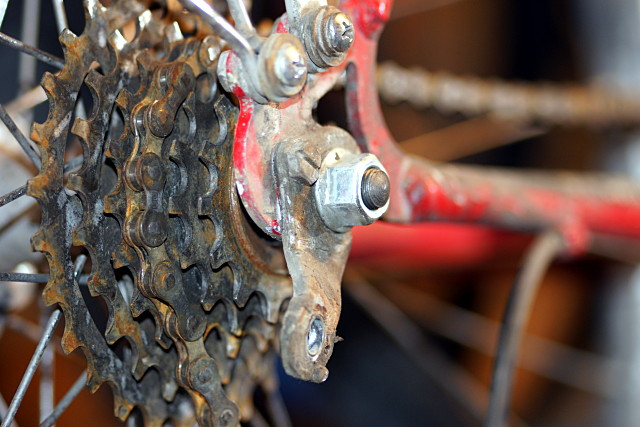
Hmm, where’d that derailleur go? I swear it was there this morning.
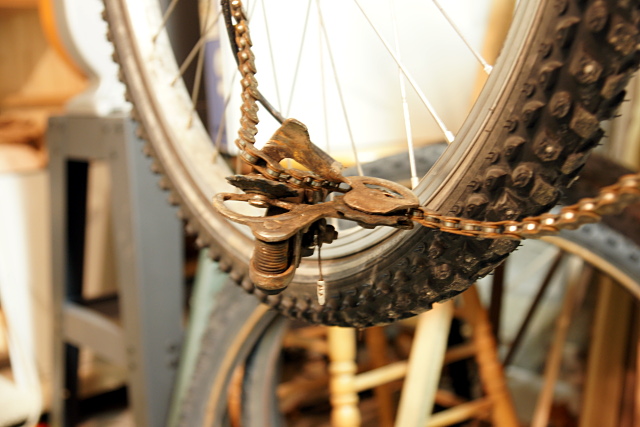
Oh, there it is. Fixing this may require just a little more than the normal amount of elbow grease.
Random Wanderings and Wonderings

Hmm, where’d that derailleur go? I swear it was there this morning.

Oh, there it is. Fixing this may require just a little more than the normal amount of elbow grease.
The City’s web page for E.T. Seton Park claims that, “cyclists can enter E. T. Seton Park from […] Don Mills Road behind the Ontario Science Centre.” If only this were true. Oh sure, there’s a roadway from Don Mills Road down to the park, but there are no bikes allowed on this hill:
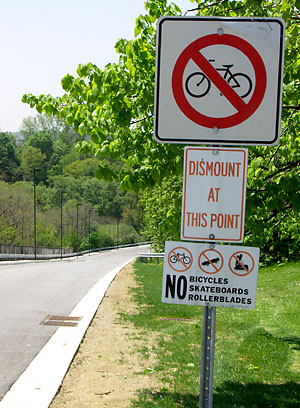
You can drive a car here, or a truck, or even a bus — it’s the roadway to the Science Centre’s main receiving area and employee parking lot, with an entrance to E.T. Seton Park at the bottom. But don’t you dare think about cycling or skating into the park. Even the official park sign a little further up the hill omits cyclists from the list of welcome visitors:
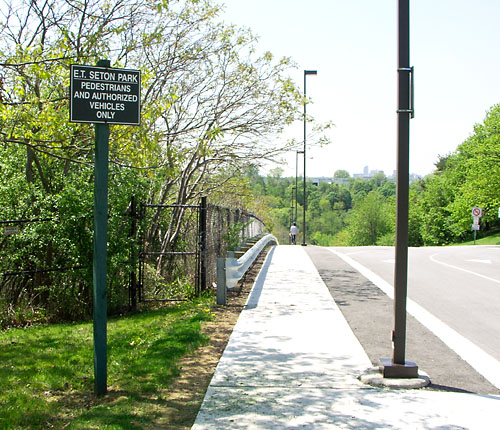
How silly. This must be what happens when you let lawyers get involved in a matter as simple as entering a park. While I’ve seen a few people walking their bikes up this hill, I’ve never seen anyone walk their bikes down. It’s not even a particularly steep descent, as roads into the Valley go.
This is not a new restriction. I remember the cycling prohibition on this hill from at least the early 90s. It’s from a different era, when cyclists were regarded as fragile nuisances to be inconvenienced and shunned at every turn. While this view is still held in some corners, much of the world has moved on. Few are the hills that still carry warnings for cyclists to dismount lest they travel too fast and lose control of their bikes, endangering themselves and offending the tender sensibilities of any nearby drivers.
At the end of a post a few weeks ago, Torontoist’s Marc Lostracco unveiled a flyer (PDF) for cyclists to stick under the windshield wipers of cars parked in bike lanes.
Not to be outdone, Spacing’s Matt Blackett released a poster he’d designed last year, chiding motorists for the same offence.
The notice (PDF) available on youparklikeanasshole.com doesn’t have a specific option for drivers that park in the bike lane, but I like it anyway.
All of this reminded me that I’d picked up a fistful of these double-sided “tickets” outside the Cycling Committee office at the East York Civic Centre last year.
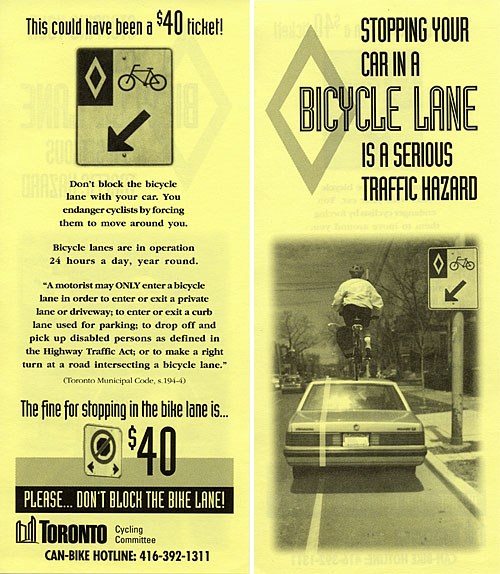
I keep meaning to ticket some bike lane parkers — especially along Queens Quay, where I rarely ride the 200 metres from Bathurst to Stadium without having to dodge at least one parked car — but always forget to put a few of these in my gear bag before I leave home.
Some variation of these tickets has been around since at least the summer of 1996, when they were mentioned in the July/August 1996 Cyclometer. I assume that some are still available at the East York Civic Centre, and probably at other locations as well.
One day after claiming that the city couldn’t find $80,000 to fund BikeShare, Councillor Glenn De Baeremaeker has suddenly found religion and is urging the city to spend over $17 million buying land in Scarborough. I now understand the problem with the BikeShare funding: the amount required simply wasn’t large enough. I mean, why dole out a few thousand dollars here and there when you can just blow it all on one big purchase? Makes perfect sense. Cuts down on administrative costs. You’ve got to spend money to save money.
Yes, I know that the land purchase and ongoing BikeShare funding are two completely different kinds of expenditures and it’s unfair to compare them. In fact, I think that the proposed Scarborough purchase would be a worthy expenditure and I support it. But the juxtaposition of the same councillor insisting that we’re too broke to afford an $80,000 program one day, and wanting to spend $17 million the next was just too juicy to ignore.
The Star reports today that after months of “shak[ing] the bushes and look[ing] under rocks,” councillor Glenn De Baeremaeker claims that the city has been unable to come up with a mere $80,000 to fund BikeShare so that it could continue to operate this year.
BikeShare is one of those community services that not only deserves to be funded, but that should be grown to ubiquity so that it becomes truly useful. Since our esteemed city council can’t find the money, allow me to offer up some bushes and rocks that De Baeremaeker may not have considered:
There you go, Glenn. Three minutes and I’ve shaken up over $250,000. You can not only fund BikeShare, but a few other worthy causes too. What’s your excuse now?
This issue is indicative of the malaise that infects Toronto council. Councillors sees nothing wrong with voting themselves raises because they make less than Mississauga councillors, catering themselves dinner because they have to work late, giving themselves free parking because they have to drive to work, handing themselves free Metropasses to encourage them not to drive to work, and on it goes.
While I don’t deny that councillors on the whole have a pretty thankless job that requires long hours, I don’t think they quite understand that many people are in the same situation, but don’t have the ability to simply award themselves perks. I can’t just give myself a raise because my next-door neighbour is making more money than me. If I’m working late, I run out to a restaurant and buy my own meal. If I have to drive to work, I feed the parking meter with my own coin. If I choose to take the TTC instead, I buy my own pass. And on it goes.
Toronto councillors preside over an $8 billion budget, yet can’t find a mere $80,000 in spare change. That’s the equivalent of someone who makes $80,000 a year not being able to find a loonie. It’s one thing to say that you don’t want to part with that dollar, and quite another to say that you don’t have that dollar. Geez pal, suck it up. Drink a coffee at home just one day a year instead of buying it at Tim Hortons, and there’s your buck right there. It’s not rocket science.
If this city is in such dire straits that accidentally dropping a loonie on the street will cause financial ruin, then councillors have no right to give themselves any perks or raises.
BikeShare is exactly the kind of program that Toronto must pay for if Mayor Miller is serious about making Toronto North America’s greenest city. If it’s to be taken seriously at all, Toronto council must find that loonie and fund BikeShare. And that’s just a start.
There seems to be a lot of angst and disappointment in the cycling community regarding the West Toronto Railpath. In particular, some cyclists are upset that this new multi-use trail isn’t a dedicated bicycle highway heading downtown. The disappointment is especially evident in a post titled This is not a bike path at the Spacing Wire and the comments that follow it.
Some cyclists seem to have built this route up in their mind so much that anything less than a DVP for bikes leading straight into the train sheds at Union Station would have disappointed.
The main issues with the Railpath seem to be:
Let’s look at these issues one at a time:
It’s too short. Well, yes. All parks and paths are. I wish the Don Valley trail system ran uninterrupted all the way up to the headwaters on the Oak Ridges Moraine.
The complaint here is that the northern section of the trail, the only part being built right now, doesn’t really “go” anywhere and thus isn’t usable as a commuting route. And that’s fair. But as the first phase in what we all hope is a 2- or 3-phase project that eventually lengthens the park when the city gains control of the southern sections, it’s a good start. No one would be happy if we simply sat on the barren corridor until the entire thing could be built, either. We have to start somewhere. The “all or nothing” approach advocated by some is unreasonable here.
It’s not a bicycle expressway. Again true, and this ties into the previous issue. But I think a lot of cyclists have been taking this expression a little too literally. There is no dedicated bike expressway in Toronto. There never has been. And there never will be, unless the city is taken over by rabid cyclists who implement Velo-city. Yet there are plenty of routes that offer speedy and/or scenic commutes.
The Railpath is, first and foremost, a park that serves its community. Expressways, whether for car or bike, divide neighbourhoods. They discourage visits to a neighbourhood and instead encourage speedy travel through them. While this may be desirable to the commuters, it is undesirable to the neighbourhood. I would certainly agree that a highway for bikes is less invasive than one for cars, but it still wouldn’t properly serve the neighbourhood that it slices through.
It’s not dedicated to cyclists. It simply doesn’t make any sense to build infrastructure solely for cyclists at the expense of other non-motor-vehicle users. The best you’ll ever get is a multi-use path. Even in parks where parallel trails exist, one is signed pedestrian-only and the other is signed multi-use for pedestrians, cyclists, bladers, and whoever else wants to use it. Cyclists will always have to share the trails with other users, and that’s the way it should be. Cyclists and pedestrians shouldn’t be adversaries. If your sole goal is to ride as fast as possible from A to B, stay on the road. And lobby your politicians for more on-road bike lanes.
The pathway is too narrow. Actually, it seems to follow the same specifications as other mixed-use paths in Toronto, including ones that are used as de facto “bike expressways” like the Lower Don and Martin Goodman Trails. I cycle the narrow Lower Don pathway frequently and rate it as far worse than the Railpath ever could be. The main problem along most of the Don south of Riverdale Park is that the park is not much wider than the pathway. If you’re not on the path, you’re in the river or scraping your face along a chain link fence.
Much of the Martin Goodman Trail and virtually the entire Don park system feature similarly narrow trails, although the parks themselves are usually wider. Yet the kind of conflicts between users that cyclists are imagining will take place on the Railpath are virtually non-existent, particularly during typical commuting hours. Yes, it would be nice to have wider or parallel pathways, but what impact would that have on the park as a whole? At just 10-15 metres wide, there isn’t a lot of room in the corridor.
It lacks links to surrounding streets. This is a valid point. The worst thing about riding the Lower Don is trying to get out anywhere other than at the very bottom or top of the trail. Leaving the trail at Riverdale Park or Queen Street means having to haul your bike up a long flight of stairs. Those bike gutters beside the steps don’t help much and most people can’t quite figure them out. I find it faster and easier to just put my bike over my shoulder and sprint up the stairs, but I’m not an occasional cyclist out for a leisurely Sunday ride.
Unfortunately, they’re proposing this same kind of stairs + gutter configuration for access to the Railpath from Bloor and Dupont. It’ll probably discourage use of the Railpath by some cyclists.
As for connections to other cycling routes, the Belt Line is similarly isolated, directly connecting only to a scary-to-the-novice pathway in the Moore Park Ravine to the south. In the north, it’s a few blocks away from the Cedarvale Ravine system. It crosses a smattering of signed routes along its length, but no streets with dedicated bike lanes. Yet the lack of direct connections to the Belt Line doesn’t prevent it from being an immensely popular and beautiful ride.
The city probably won’t plough the route. Yes, welcome to the reality of off-road routes in Toronto. I’m not aware of any mixed-use path that receives city attention in the winter. There’s no reason that the Railpath would receive winter maintenance that no other trail in Toronto does.
That said, I think the Railpath should be ploughed in the winter. As should all of the other paved mixed use paths commonly used for bicycle commuting. But the city can’t afford it, you say? Nonsense. Since it’s already the responsibility of landowners to clear the walks in front of their homes and businesses, I’d like to see the city stop its sidewalk clearing service and instead dedicate its sidewalk ploughs to clearing park pathways instead. It would even end up saving money, as there aren’t nearly as many park pathways to clear as there are sidewalks. The city could continue to shovel for seniors and the disabled.
Although some parks are used in the winter by cross-country skiers and snowshoers (of which I’m one), they should still be able to ski or shoe beside the cleared paths. Dog walkers, cyclists, and nature lovers would rejoice.
I’d lobby my out-of-touch city councillor in this direction, but I highly doubt that he would take any cycling issue seriously.
Landscape Architect David Leinster of The Planning Partnership presented his group’s recommendations for the future management of Crothers’ Woods at a public meeting last night. The meeting was attended by about 30 people, less than half of the number that attended the initial consultation in November. I suspect the lower turnout was because the meeting wasn’t widely publicized — I only found out about it from a post on the Don Watcher blog and couldn’t find any mention on the City’s web site.
Crothers’ Woods is an environmentally sensitive area in the Don Valley bounded roughly by Pottery Road & Bayview Avenue to the south, the CP tracks to the west, Millwood Road to the north, and the Don River to the east. Although it has no formal access points, it is a very well-used park. Identified users include hikers, dog walkers, trail runners, orienteers, school groups, and birders, but mountain bikers are the primary users of the park by far. They have created an astounding array of trails complete with ladders, teeter-totters, and other constructed elements to make the trails more interesting and challenging. Unfortunately, they’ve also created a looming ecological problem because the current trail system increases soil erosion and instability.
The primary issues that the master plan addresses are restoring the natural environment where it has been degraded by human activity and invasive species, and mitigating the further negative effects of human activity. It sets out a variety of common-sense measures to meet these goals, including native species plantings and “manual” plant control (which I took to mean “weeding”).
As for the trails, they’ll be realigned in many places and closed in the most sensitive or degraded areas. Of approximately 10 km of existing trails, 1.8 km are slated for closure. The rest will be realigned along natural contours of the land where necessary and will be managed along sustainable trail building principles as identified by the International Mountain Bicycling Association.
Also included in the plan will be new directional and wayfinding signage on the trails. This will help cyclists like me stay on the beginner trails and go in the right direction at a fork in the trail. Access to the park will be upgraded from about 10 informal access points to a half-dozen formal trail heads with information kiosks, community bulletin boards, trail maps, and other information. Two of these trail heads, at the base of Pottery Road and behind the Loblaws on Redway Road, will include parking.
Most of the above is non-controversial. The same can’t be said for the plan to close off access to the area known as “the Flats.” A Don Watcher entry provides some background detail about the Flats, including pictures. The study identified this area as among the least ecologically sensitive, so why is it being closed off? It’s all to do with the railway. The area is in a bit of a no-man’s land, requiring users to cross the CN tracks that run along the bottom of the Valley. Unfortunately, the crossing is illegal. CN has been unresponsive to the idea of installing a legal crossing in the area, so the architects of the master plan felt they had no choice but to cut the Flats off from the rest of the park.
End of story for the Flats? Well, it could have been if not for the public consultation. A couple of people at the meeting asked why it wasn’t possible to put bridges across the river, joining the Flats to the main paved Don pathways near Beechwood Drive and Don Mills Road. This would effectively do away with the troublesome railway crossing and enhance access to the Flats.
The answer from the City’s representative, Garth Armour, was that it had simply never occurred to them. He added that he’d look into the possibility, and that there might even be money in the budget for it. So the Flats may be saved after all.
I mention this incident not to condemn the City or the master planners, but to underscore the value of public input into the process. Sometimes, it takes an outsider to point out a painfully simple solution to a room full of experts. It’s not that the experts are stupid, it’s just that the process can become so focussed on one aspect of a problem (how to join the Flats to the rest of Crothers’ Woods across the railway tracks) that they can’t easily see an external solution (join the Flats to the rest of the Valley park system instead).
I’ve been in similar situations myself, where a group of like-minded professionals are concentrating on solving an intractable problem. Then someone else comes along with a dead-simple suggestion and we feel like complete idiots for not seeing the obvious. It’s the professional equivalent of ranting at technical support because your computer is broken, only to discover that you forgot turn your monitor on.
We won’t know until the final master plan is delivered to the city in a few weeks whether the bridge idea or some other idea for the Flats is considered feasible. Either way, implementation of the plan is slated for 2008.